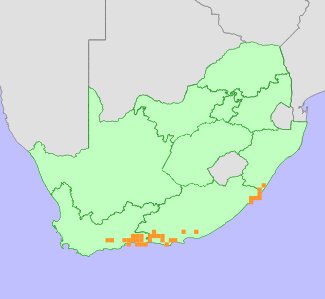|
Scientific Name | Podalyria burchellii DC. |
Higher Classification | Dicotyledons |
Family | FABACEAE |
Synonyms | Podalyria burchellii DC. var. albida Walp., Podalyria cana Willd., Podalyria lancifolia Eckl. & Zeyh., Podalyria myrtillifolia Willd. var. myrtillifolia in sense of E.Mey. (in part), Podalyria velutina Burch. ex Benth. |
Common Names | Hairy Blossom-pea (e), Keurtjie (a) |
National Status |
Status and Criteria | Least Concern |
Assessment Date | 2020/11/26 |
Assessor(s) | A.L. Schutte-Vlok & D. Raimondo |
Justification | Podalyria burchellii is a widespread species with an extent of occurrence (EOO) of 80 340 km². It has both sprouting and non-sprouting forms. Many subpopulations occur within montane areas and are not declining, and therefore it is listed as Least Concern. |
Distribution |
Endemism | South African endemic |
Provincial distribution | Eastern Cape, KwaZulu-Natal, Western Cape |
Range | This species is endemic to South Africa, and is found from Langeberg to Tsitsikamma mountains and inland along the Swartberg, Kammanassie, Kouga and Baviaanskloof mountain ranges east to the Pondoland area in the Eastern Cape and southern KwaZulu-Natal. |
Habitat and Ecology |
Major system | Terrestrial |
Major habitats | Kouga Grassy Sandstone Fynbos, Kouga Sandstone Fynbos, South Kammanassie Sandstone Fynbos, North Kammanassie Sandstone Fynbos, Tsitsikamma Sandstone Fynbos, South Outeniqua Sandstone Fynbos, North Outeniqua Sandstone Fynbos, South Langeberg Sandstone Fynbos, North Langeberg Sandstone Fynbos, Suurberg Quartzite Fynbos, Garden Route Granite Fynbos, Knysna Sand Fynbos, Pondoland-Ugu Sandstone Coastal Sourveld |
Description | It occurs in soils derived from sandstone formations. The subpopulations in the Pondoland area occur in marshy deep sandy soils along streamsides, other subpopulations occur in arid mountain fynbos. |
Threats |
| Threats to Podalyria burchellii include habitat degradation, habitat loss, harvesting and invasive alien species. |
Population |
There is no information available on the population of this species.
|
Population trend | Stable |
Assessment History |
Taxon assessed |
Status and Criteria |
Citation/Red List version | | Podalyria velutina Burch. ex Benth. | NT B1ab(iii,v)+2ab(iii,v) | 2012.1 | | Podalyria burchellii DC. | Least Concern | Raimondo et al. (2009) | | Podalyria velutina Burch. ex Benth. | NT B1ab(iii,v)+2ab(iii,v) | Raimondo et al. (2009) | | Podalyria velutina Burch. ex Benth. | Lower Risk - Near Threatened | Scott-Shaw (1999) | | Podalyria burchellii DC. | Not Threatened | Hilton-Taylor (1996) | | Podalyria velutina Burch. ex Benth. | Indeterminate | Hilton-Taylor (1996) | |
Bibliography |
Boon, R. 2010. Pooley's Trees of eastern South Africa. Flora and Fauna Publications Trust, Durban.
Hilton-Taylor, C. 1996. Red data list of southern African plants. Strelitzia 4. South African National Botanical Institute, Pretoria.
Raimondo, D., von Staden, L., Foden, W., Victor, J.E., Helme, N.A., Turner, R.C., Kamundi, D.A. and Manyama, P.A. 2009. Red List of South African Plants. Strelitzia 25. South African National Biodiversity Institute, Pretoria.
Schutte-Vlok, A.L. and Van Wyk, B.E. 2011. A taxonomic revision of Podalyria (Fabaceae). Systematic Botany 36(3):631-660.
Scott-Shaw, C.R. 1999. Rare and threatened plants of KwaZulu-Natal and neighbouring regions. KwaZulu-Natal Nature Conservation Service, Pietermaritzburg.
Victor, J.E. and Dold, A.P. 2003. Threatened plants of the Albany Centre of Floristic Endemism, South Africa. South African Journal of Science 99:437-446.
Vlok, J. and Schutte-Vlok, A.L. 2010. Plants of the Klein Karoo. Umdaus Press, Hatfield.
|
Citation |
| Schutte-Vlok, A.L. & Raimondo, D. 2020. Podalyria burchellii DC. National Assessment: Red List of South African Plants version . Accessed on 2025/06/02 |
 Comment on this assessment
Comment on this assessment

